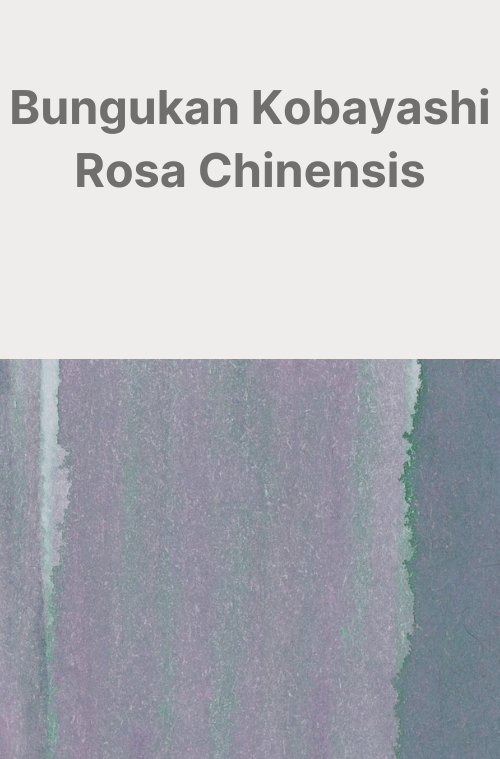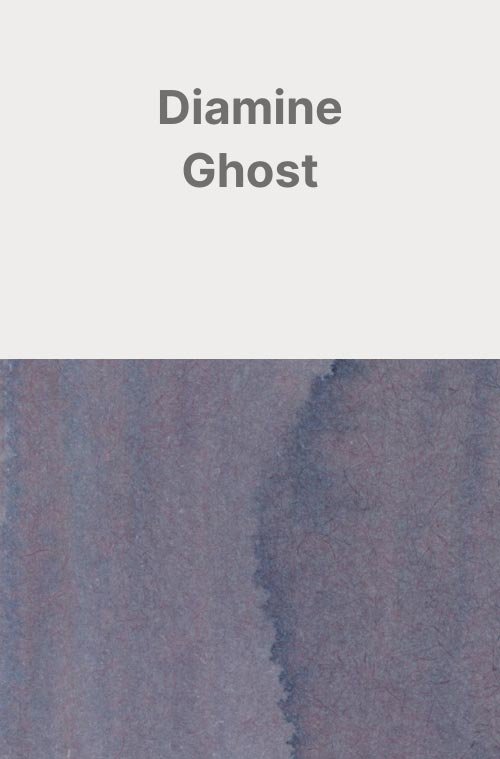Bungukan Kobayashi Rosa Chinensis
Ink Review #73
*Please note that the scan is the accurate representation of this color.
Overview
The color/properties:
Rose Chinensis is a multi-shading ink. It’s a misty blue-grey with heavy pink undertones, especially in areas where the ink pools the most. There are hard, darker edges around the shading areas as well. If you lay the ink down heavily enough, you might notice hints of green, but I wouldn’t expect this as part of the typical writing experience. With that said, Rose Chinensis displayed its shading effects the strongest on the Tomoe River paper, where the shading areas appeared with a brighter pink hue, and even the green edges showed up regularly. The shading characteristics also appeared well on Midori, but I found that the ink took on a more violet appearance overall compared to the other papers.
This ink was particularly pale and difficult to make out with the finer nibs, going as far as to take on a faded blue tonality. With the medium nib and larger, however, the ink darkened up considerably and legibility was no longer an issue.
Another thing to note: it has the distinctive Sailor ink smell. You might love it, you might hate it, but it’s there and you can smell it while writing.
Ink Splat
Ink Droplets
Rhodia
Leuchtturm1917
Performance on paper:
For a drier ink, there was a surprising amount of bleed-through on the Kokuyo sheet. It was mostly spot bleeding with the larger nib sizes, and there wasn’t any bleeding or feathering on the other test sheets. This ink should be fine with most fountain pen-friendly papers, even with wetter-tuned nibs (which I recommend with this ink, but we’ll get to that in the next section). The dry times were great as well, mostly with the large nib sizes drying within 10-15 seconds, and only one instance on Maruman where it took 20.
The dry times were also not the best, with even the fine and extra fine nibs taking up to 20 seconds to dry on some of the papers, and one instance on Tomoe River with the Architect nib that failed to dry within 30 seconds. I was even doing some extracurricular journaling with this ink, and some areas of the writing were taking longer than a minute to completely dry. This wouldn’t be the best choice if you need to close a notebook on it quickly.
Unfortunately, there wasn’t a lot in the way of water resistance. Something might be salvageable if the ink is exposed to water, but I wouldn’t count on it.
Midori MD
Maruman
Tomoe River
Kokuyo
Water resistance
Chromatography
Performance in the pen:
The first thing I noticed upon inking this up, is that it’s as dry as you’d expect from a multishading ink, in both flow and lubrication. But it’s not that dry either. It’s not intolerable. If you like your inks to be very flowy and juicy though, this isn’t going to be a good experience in the slightest. On the subject of dry flow, it also led to performance issues, notably consistent hard starts with fine, medium, broad, and stub nibs. It was a pretty frustrating experience, but that’s why I mentioned recommending it with a higher flow nib, or if not, a very well-tuned one.
I expected cleaning to be easy, and while the nibs cleaned out with a simple flush and soak, there was a lot of residue left over inside the pen as well as light staining of the barrel. It wasn’t that easy to get out either; it took a lot of scrubbing with technical pen cleaner to get out, as well as a lot of passes with fine brushes to get the staining out of the threads where the nib units screw into the barrel. This shouldn’t be that big of a deal with a pen that uses cartridges or converters that are easy to clean, but I would recommend against using this ink with integrated filling systems that are difficult to access.
Written on Leuchtturm1917 paper, this is the grey color the ink takes on when written on most papers.
This was written on 52gsm Tomoe River paper. Here it takes on a much more purple/pink tonality.
Performance in a pen: 6/10
Performance on paper: 9/10
Color saturation: 5/10
Sheening: 0/10
Shading: 10/10
Dry time: 9.5/10
Water resistance: 1/10
Ease of cleaning: 4/10
Shimmer: None
My personal thoughts...
I was given the opportunity to review this ink by someone who brought it over from Japan (Thank you!). It seemed to be a Sailor ink of some sort (Sailor bottle, watermarks on the packaging, the smelly Sailor smell), but it was obscure and unlike any other that I had seen before. Unsure of its origins, I was tasked with uncovering more about it. How can I decline an opportunity like that? Thankfully, that’s what I’m good at! So, it’s a Sailor shop special, made for Stationer’s Kobayashi, a stationery chain in the Shizuoka prefecture of Japan. In fact, it’s one of 29 inks in their own Shizuoka ink set, which draws inspiration from its namesake region. Mystery solved!
Now as for the ink itself!
If you’ve perused Stationer’s Kobayashi’s web page at this point, you might have found that their marketing material for this particular ink displays a swatch that’s much brighter and far more purple than what I have here. Even stranger, the art on the bottle is far closer to the ink that I’ve been working with. Why that is, I can’t say for sure, but this is a fresh bottle from Japan, and I can’t imagine that it’s gone bad already. What I can say, is that it doesn’t exactly look like any variation of a China Rose (Rose Chinensis) that I’ve seen either way. Maybe it would be closer if it looked more like the marketing material. On the other hand, it’s still a very nice multi-shading ink. If that’s what you’re looking for, I’d recommend it, assuming you can get your hands on it in the first place, but only with the right pen to combat that dryness.
Written in a 52 gsm Tomoe River notebook with a Sailor 1911S (Zoom nib)
Written in a Leuchtturm1917 notebook with a Sailor 1911S (Zoom nib)
Compare:
More images/info:
Tools and materials used in the writing samples:
A TWSBI Diamond 580 AL with 7 nib units including a Needlepoint grind, EF, F, M, B, 1.1mm stub, and an Architect grind. All nibs are tuned to perform at the same medium wetness.
A Rhodia No16 A5 DotPad
A Leuchtturm1917 A5 Notebook
A Midori MD A5 Notebook
A 68gsm A5 Tomoe River Notebook
A Maruman Mnemosyne A5 Spiral Notebook
A Kokuyo Campus A5 Notebook















